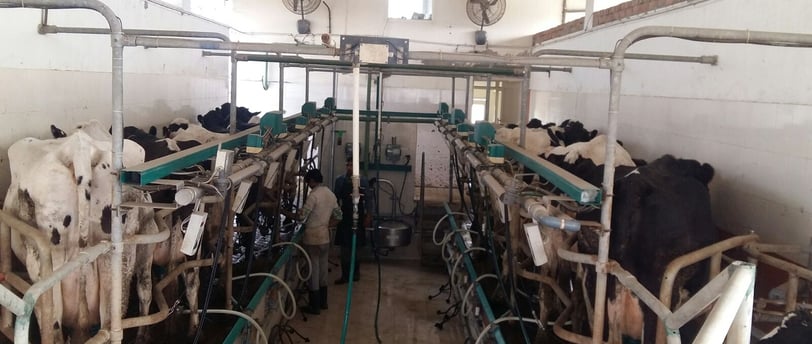Revolutionizing Dairy Farming: How IoT is Enhancing Milk Production
7/25/20243 min read


Dairy farming, a cornerstone of agricultural production, has long been integral to sustaining the global supply of milk. Today, large-scale dairy farms are leveraging modern technology, particularly the Internet of Things (IoT), to automate milking systems, monitor cattle health, and ensure sustainability. This post delves into how IoT is transforming milk production and helping dairy farmers meet the demands of a growing population.
Embracing Precision Farming
IoT enables precision farming by providing real-time data and insights to farmers. This technology helps in monitoring and developing a database for capturing competitive market data and enhancing productivity. Here's how IoT contributes to various aspects of dairy farming:
1. Breeding Infrastructure and Genetics
The success of dairy farming often hinges on the quality and productivity of the herd. IoT helps in:
Tracking Breeding Cycles: Sensors monitor cows' activity and health, providing crucial data on optimal breeding times.
Enhancing Genetics: Data from IoT devices can inform breeding decisions, supporting advanced methods like artificial insemination and embryo transfer to improve herd genetics.
2. Animal Feed and Fodder Management
Quality feed is vital for high milk production. IoT assists in:
Precision Feeding: Automated feeding systems dispense the right amount and type of feed based on individual cows' nutritional needs.
Monitoring Feed Intake: Sensors track feed consumption, helping to optimize diets and prevent health issues related to poor nutrition.
3. Animal Health
Healthy cows are productive cows. IoT enhances animal health management by:
Continuous Health Monitoring: Wearable sensors track vital signs and activity levels, alerting farmers to potential health issues before they become serious.
Preventive Care: Data analytics help predict and prevent diseases, reducing the need for medical treatments and ensuring better overall herd health.
4. Farm Mechanization
With labor shortages and high labor costs, mechanization is crucial. IoT contributes by:
Automated Milking Systems: Robots equipped with IoT sensors can milk cows efficiently, ensuring optimal milk extraction and reducing stress on the animals.
Monitoring Equipment: IoT devices monitor the condition and performance of farm machinery, predicting maintenance needs to prevent breakdowns.
5. Cold Chain Infrastructure
Maintaining milk quality from farm to consumer is critical. IoT aids in:
Temperature Monitoring: Sensors in chilling plants and bulk coolers ensure that milk is stored at the right temperature, preventing spoilage and contamination.
Power Management: IoT can integrate with solar-powered chillers to mitigate issues caused by electricity shortages, ensuring a consistent cooling chain.
6. Quality Testing Infrastructure
Consumers demand safe, high-quality milk. IoT supports quality assurance by:
Real-Time Quality Testing: Sensors at milk collection centers test for quality parameters, ensuring that only the best milk reaches consumers.
Trained Workforce: IoT systems can guide less experienced workers through complex testing procedures, enhancing overall quality control.
7. Processing Equipment and Food Ingredients
IoT helps dairy processors innovate by:
Optimizing Production: IoT devices monitor and control processing equipment, ensuring efficient production and reducing waste.
Enhancing Products: Data from IoT sensors can inform the development of new dairy products, meeting consumer demands for diverse and high-quality options.
8. Waste and Byproduct Management
Efficient waste handling is essential for sustainable farming. IoT contributes by:
Monitoring Waste: Sensors track waste production and management, helping to minimize environmental impact.
Utilizing Byproducts: IoT data can optimize the use of byproducts like whey and buttermilk, turning them into valuable resources.
Impact of IoT on Smart Dairy Farming
IoT technology has become a game-changer in dairy farming by integrating multiple data sources and enhancing various aspects of milk production. Key benefits include:
Increased Milk Yield: IoT helps optimize feeding, health, and milking processes, leading to higher milk production per cow.
Reduced Labor Costs: Automation and data-driven management reduce the need for manual labor, cutting costs and improving efficiency.
Enhanced Animal Welfare: Continuous monitoring ensures timely intervention for health issues, improving the overall well-being of the herd.
Sustainability: IoT enables better resource management, reducing waste and environmental impact.
Future Prospects
The integration of IoT with Artificial Intelligence (AI) promises even greater advancements. AI models can analyze data from IoT sensors to provide predictive insights, such as the optimal times for milking and feeding adjustments. This combination of IoT and AI will continue to push the boundaries of smart dairy farming, making it more efficient, sustainable, and profitable.
In conclusion, IoT is revolutionizing dairy farming by providing farmers with the tools to enhance productivity, ensure animal welfare, and maintain sustainability. As technology continues to evolve, the dairy industry will undoubtedly see even more innovative solutions to meet the challenges of modern milk production. Embracing IoT is not just an option but a necessity for dairy farmers aiming to stay competitive and sustainable in the global market.
India IoT Hub
© 2024. All rights reserved.
Company
About Us
Contact Us
Blog
Resources
Services
Mobile Apps
IoT Development
Web Apps
